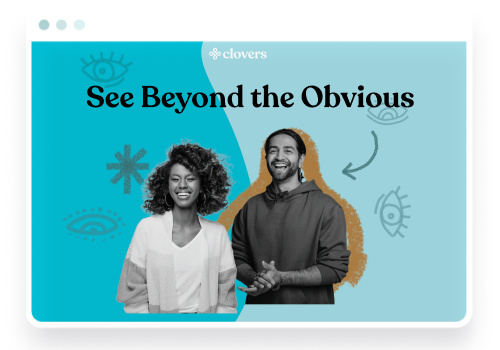Nearly 95% of large corporate diversity recruiting efforts routinely fail to meet their Diversity, Equity & Inclusion (DE&I) goals. Make sure your organization doesn’t fall into the same trap by developing a strong diversity hiring strategy.
In this blog post, we’ll explore what diversity hiring is and why it matters. Most importantly, we’ll share 14 strategies you can use to support your diversity hiring process at every stage of the candidate journey.
What is diversity hiring?
Diversity hiring is not about hiring people from different backgrounds just to meet DEI metrics. Instead, diversity hiring removes barriers to hiring qualified, diverse candidates.
Diversity hiring reduces biases related to a candidate’s age, race, gender, religion, ethnicity, sexual orientation, disability, or any other characteristic that has no bearing on job performance. With a focus on eliminating the biases that could prevent qualified candidates from being hired, diversity-minded hiring practices ensures candidates are evaluated fairly.
Why is diversity hiring important in the hiring process?
The first step in building a diverse workforce is delivering an inclusive hiring process. An inclusive hiring process makes all candidates feel welcome to apply, builds a more diverse talent pool, and helps you find more qualified candidates.
A diverse workforce helps attract top talent, ensures employee satisfaction and retention, and improves innovation and the bottom line. And, because DEI in the work environment is so valuable, diversity hiring is becoming a priority for everyone from job seekers and employees to HR leaders and the C-suite.
How does unconscious bias influence hiring decisions?
Humans are instinctual creatures. And while our instincts evolved to protect us from danger—think woolly mammoths and saber-toothed tigers—relying on them in the hiring process leads to bad hires, discriminatory hiring practices, and a lack of workplace diversity.
During the interview process, for example, most people decide if they like someone or not almost immediately. It’s natural to gravitate toward people you instantly connect with, but relying too much on gut instinct in the hiring process allows unconscious bias to influence hiring decisions.
Unconscious bias permeates all aspects of the recruitment process. Unfortunately, these biases prevent companies from achieving and realizing the benefits of a truly diverse workforce.
14 hiring strategies for improving diversity
As you set out to improve your diversity and inclusion hiring strategy, these 14 strategies will help you find success.
1. Set clear diversity hiring goals
Saying you want to improve diversity hiring is a worthwhile goal but not an actionable one. Since you can’t improve what you can’t track, the first step is to set clear goals around diversity hiring.
Start by choosing at least one recruiting metric and define what success looks like. For example, it could be to increase the number of qualified female candidates applying for tech-related roles by 15% within 12 months. By tracking and reporting on your diversity hiring goals, you can drive accountability and action.
2. Have a diverse hiring team
We all tend to favor people like ourselves. But when you’re building a diverse workforce, you need a diverse team of interviewers. When the hiring team is made of people from diverse backgrounds that can offer different perspectives, you eliminate the groupthink and echo chambers that often produce homogenous hiring.
Train hiring team members to recognize biases that lead to unfair hiring decisions. Provide coaching opportunities and allow for teams to have open dialogues with one another.
3. Create inclusive job descriptions
The words you use in your job descriptions have a huge impact on your ability to attract diverse job applicants. Use gender-neutral language and avoid words and phrases that can subconsciously turn off diverse candidates. An inclusive job descriptions tool can help you identify these terms.
For example, words and phrases often seen in job ads like “ninja,” “dominate,” “rockstar,” and “work hard, play hard,” tend to repel female candidates and older candidates. Avoid using jargon and “company-speak”—the internal corporate language of your organization. It can make prospective employees feel unqualified and discourage them from applying too.
4. Use artificial intelligence (AI) during the recruiting process
From auto-screening candidates to more effective interviewing, AI has many applications that help recruiting teams hire faster, smarter, and with less bias. Using the right tools will support your diversity efforts and ensure that the best person for each role is hired.
Standardizing interviews with AI-powered video interview software can keep biases and guesswork out of hiring decisions. Interview transcripts can help teams make smarter decisions. And resume review software can also screen resumes for keywords or redact personal information for a more fair evaluation.
5. Build a diverse talent pipeline with employee referrals
Employee referrals are usually an employer’s top source of hire. Unfortunately, they can contribute to a homogeneous workforce. To overcome this and get your entire organization thinking about diversity, connect your diversity hiring initiatives with your employee referral initiatives.
To build a diverse talent pipeline, start by asking employees for more diverse candidate referrals. For example, you might ask, “Who’s the best female engineer you know?” When Pinterest asked its engineers to refer candidates from underrepresented backgrounds, the results were astounding: it saw a 24% increase in the number of women referred and a 55% increase in the number of candidates from diverse ethnic backgrounds.
6. Use a variety of sourcing channels
Intentionally seek out opportunities to source diverse candidates. Share openings on job boards that serve diverse communities. For example, some job pages specifically serve Black job seekers, women, or Latinx applicants. Look for potential new employees at Historically Black Colleges and Universities (HBCUs) or all-women’s colleges.
In the same way, connect with job seekers by attending career fairs that serve diverse candidates. Some career fairs are broad and for all diverse candidates, while some are more specific, like the “Women in Tech” career event.
7. Train interviewers on bias awareness
Even if you recruit diverse candidates, what happens when they get to the interview phase? Ensure candidates continue to have a positive, inclusive hiring experience with interviewers who actively work to mitigate bias.
One of the best ways to ensure your interviewers are fair and inclusive is to provide education. Your hiring team and interviewers can’t fix what they don’t know is wrong. Help them identify their own biases and work towards growth. You can offer an online training program, a workshop, or moderate discussions to help support unbiased interviews.
8. Use interview guides
Interview guides are an essential part of your diversity and inclusion hiring strategy. They help interviewers deliver consistent interviews with the same set of questions for each candidate. With a structured interview, there is less opportunity for biased or irrelevant questions.
Interview guides also help hiring teams make smarter hiring decisions. When candidates are given the same questions, it’s easier to compare and contrast their responses. Interview guides also ensure a consistent candidate experience for every applicant.
9. Host events that specifically target diverse candidates
Host events that draw diverse candidates in. Casual mixers or other networking events advertised to diverse communities will allow you to connect with more diverse talent. Consider inviting candidates to an open house at your workplace, or host an in-person or digital happy hour.
Organizing panel discussions can help you interest and engage diverse candidates too. Or connect with community groups that support diverse populations. Partner with them to sponsor events or support their volunteer opportunities to make more connections.
10. Establish paid internship or mentorship programs
Research shows that internships often benefit privileged students who can take unpaid positions. This disadvantages underprivileged and underrepresented groups. On the other hand, paid internships give diverse candidates the chance to learn more about fields they might not have had access to before. Offer paid internships to develop diverse talent.
Mentorship programs will also support your diverse hiring strategy. Mentoring empowers diverse employees as they further their careers, develop their skills, and connect with other professionals. Mentorship programs will attract more diverse talent and retain the great talent you have.
11. Record video interviews
Don’t rely on recall when you’re discussing interviews with other decision-makers. Memory can unknowingly be shaped by bias. Record live video interviews or one-way asynchronous interviews and use the footage as evidence when discussing an applicant’s strengths or weaknesses. You’ll have data to back up your hiring choices.
Video recordings of interviews also provide coaching opportunities for interviewers. If an interviewer asks a biased or personal question, instead of compliant interview questions, the moment can be flagged for future learning. Recordings hold interviewers accountable for delivering fair, consistent interviews.
12. Offer flexible work arrangements
Many job seekers and employees appreciate flexibility at work. If you can allow flexible work arrangements, you’ll attract more candidates. And you’ll be able to accommodate employees with unique responsibilities or requirements. Parents, workers from other countries, people with disabilities, or caregivers appreciate the chance to tailor their workday to meet their needs.
Flexible work arrangements include remote work, flextime, compressed workweeks, or job sharing. Offering leave for medical conditions or family emergencies, parental leave, or guaranteed time off will also appeal to candidates in search of flexibility.
13. Establish company-wide diversity and inclusion initiatives
Your commitment to diversity and inclusion in the workplace goes beyond your hiring strategy. DEI should be a part of your company culture from job descriptions to executive board meetings. You need buy-in—all employees, present and future, should appreciate the value of DEI at work.
Once you have buy-in, you’ll have the support you need to further DEI initiatives. Develop new company policies if needed. Establish employee resource groups (ERGs). And take the time to acknowledge and celebrate the diversity within your organization. Observe a range of holidays and appreciation days.
14. Regularly track and analyze data
Follow through on your diversity strategy by gathering data and measuring its success. Collecting data will help you see what’s working or what can be improved. Data also offers proof to stakeholders that your efforts are paying off.
Track the demographics of new hires, like their race or gender, your company’s profitability, and turnover. Survey employees to measure engagement, gather pay information to ensure pay equity, and track promotion rates amongst diverse employees.
How intelligent interviews can improve diversity recruiting
With a stronger diversity hiring strategy, you can build a more diverse pool of candidates, optimize hiring practices for diversity, and create a more inclusive workplace. While we can’t eliminate human biases completely, technology can help reduce their impact on the interview process and hiring decisions.
With an intelligent hiring solution like Clovers, every candidate has an equal opportunity to show their full potential, and companies can easily evaluate candidates based on more fair, more objective criteria.
Ready to improve your diversity hiring?
Schedule a demo to learn how Clovers’ intelligent hiring solution can help you reduce unconscious biases in the hiring process and deliver inclusive, equitable interviews for all.
Not ready for a demo?
Check out this guide

